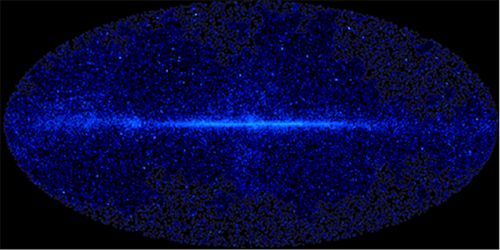Blazar Tally
For some time, telescopes tuned to the high end of the radiation spectrum—gamma rays—have detected a faint glow coming from outside our Galaxy. This so-called extragalactic gamma-ray background comes from sources that are too dim or diffuse to resolve with a telescope, and scientists have speculated that some of it might come from unconventional objects like dark matter. Exactly how much can be attributed to unknown sources is now clearer, thanks to an analysis by scientists working with the Fermi Large Area Telescope (LAT). They estimate that all but 14% of the background above 50 GeV is produced by blazars—powerful jets of particles emanating from black holes at the centers of galaxies.
In 2015, the Fermi LAT researchers used 80 months of data from the satellite-borne telescope to identify 253 gamma-ray sources located outside our galaxy, including roughly 60 previously unresolved sources. Based on the spectral properties of the sources, the scientists estimated that nearly all of them were blazars. In their new study, they analyzed the detected sources to simulate a map of extragalactic blazars, most of which would be too weak for the LAT to see. They then calculated the total flux expected from all of the blazars in the simulated map and showed that it constituted 86% of the gamma-ray background. The finding could be used to put constraints on various theories that link gamma rays to dark matter or to sources of ultra-high-energy neutrinos.
This research is published in Physical Review Letters.
–Jessica Thomas





